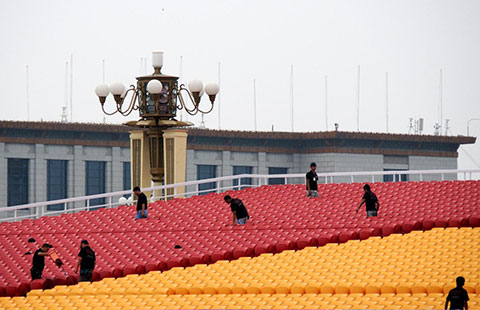China won’t change policy because of overestimated emissions
Updated: 2015-08-21 03:22
By REUTERS in Beijing and CHEN WEIHUA in Washington(China Daily USA)
|
||||||||
 |
|
A power plant is emitting waste gas and smoke in Yichang, Hubei province, Sept 22, 2014. PROVIDED TO CHINA DAILY |
Experts believe the latest report about previous overestimation of China’s carbon emissions will not affect the Chinese government’s environmental policy and its stance in the upcoming United Nations Climate Conference in Paris in December.
A study published on Wednesday by Nature said international organizations could be overestimating emissions from China, the world’s biggest producer of greenhouse gas because of problems in the way they calculate their data.
The paper said organizations like the European Union's Emissions Database for Global Atmospheric Research (EDGAR) have overestimated China's emissions by as much as 14 percent by using default conversion rates that should not apply in China.
Ranping Song, a team leader for the China Climate Program at the World Resources Institute, believes the adjustment in data will not have a fundamental effect on Chinese government policy or the conference in Paris, which aims to conclude a legally binding and universal agreement on climate.
“The main reason is that we believe that many of the climate actions China has been taking are due to the needs of the new development model, or known as the new normal that would require carbon reductions,” Song told China Daily on Thursday, adding that the Chinese have realized the harmful consequence of air pollution.
Because of these factors, Song believes that the change of statistics will not have a major impact on China’s strategy and stance, including the joint announcement in Beijing last November by Chinese President Xi Jinping and US President Barack Obama in which China promised to peak its carbon emissions by 2030 or earlier.
Song noted that the Chinese government departments have been improving their data collecting system to make their statistics more accurate. But he noted that the less than frequent announcement of the data by the Chinese government means that many have turned to figures from other sources, such as International Energy Agency or BP. The last carbon emission figures provided by the Chinese government were for the year 2005.
While the study might ease some of the pressure on China, it still has a lot to do to rein in its spiraling greenhouse gas emissions, said Dabo Guan, chair of Climate Change Economics at the University of East Anglia, and one of the authors of the Nature study.
“Our estimates, which use a lower emission factor, don’t change the fact that China is still the largest emitter in the world,” he said.
“This will give some carbon space for the less-developed regions in China but it is not a game-changer. It won’t disrupt China's mitigation efforts.”
While there is no official figure for Chinese carbon emissions last year, estimates stand at around 9-10 billion tonnes, while forecasts for 2030 range anywhere between 11 billion and 20 billion tonnes, according to a Reuters report.
“Without an accurate baseline, any target will become a number-crunching game,” Guan said.
“The main difference in our paper is for the first time we have taken fuel quality into consideration, which is missing from other estimates,” said Guan.
Taking into account China's lower quality coal, the study calculated China’s 2013 carbon emissions at 9.13 billion tonnes, below the EDGAR figure and 5.6 percent lower than an estimate in oil major BP’s statistical yearbook.
The Intergovernmental Panel on Climate Change (IPCC) recommends a default “emission factor” of 0.713 tonnes of carbon for every tonne of coal produced, but the Nature authors, looking at around 600 samples from domestic mines, said the figure in China should be closer to 0.518 tonnes.
The study also estimated China produced 2.9 gigatonnes less carbon dioxide than previous estimates over 2000-2013, although Chinese government researchers said it might have overestimated lower-grade coal consumption over the period.
“More cheaper poor quality coal was supplied in 2013 as the industry was hit by lower demand in China,” said Jiang Kejun of the Energy Research Institute, a government think tank. “It is not accurate to use emission factors for a single year to calculate China's emissions.”
The last time Beijing gave an official number for 2005, the emissions stood at “approximately” 7.47 billion tonnes. It is due to submit an updated number for 2010 next year.
- Emission limits to ensure blue sky
- China's BYD signs deal to provide zero-emission buses to London
- New GM rice 'can cut greenhouse emission'
- China's all provincial regions reach pollutants emission cut target
- California mulls move to 'zero-emission buses'
- Li promises carbon emission cuts
- Beijing to implement new air pollutant emission standards

 Stars in their eyes: leaders in love
Stars in their eyes: leaders in love
 A survival guide for singles on Chinese Valentine’s Day
A survival guide for singles on Chinese Valentine’s Day
 Beijing police publishes cartoon images of residents who tip off police
Beijing police publishes cartoon images of residents who tip off police
 Rare brown panda grows up in NW China
Rare brown panda grows up in NW China
 Putin rides to bottom of Black Sea
Putin rides to bottom of Black Sea
 The changing looks of Beijing before V Day parade
The changing looks of Beijing before V Day parade
 Nanjing displays ancient marriage, divorce certificates
Nanjing displays ancient marriage, divorce certificates
 Top 10 Android app stores in China
Top 10 Android app stores in China
Most Viewed
Economy on path of steady growth[1]|chinadaily.com.cn
Gay sex poses HIV threat for youth|Society|chinadaily.com.cn
Japan to release videos of Chinese activists|Asia-Pacific|chinadaily.com.cn
Gay sex blamed for rise in young students with HIV/AIDS|Society|chinadaily.com.cn
More young adults living with parents|Americas|chinadaily.com.cn
Magazine seeks Guangzhou expat families to tour Fujian[1]|chinadaily.com.cn
World's longest sightseeing escalator awaits you in Central China[4]|chinadaily.com.cn
Dai Ethnic Group[1]|chinadaily.com.cn
Minmetals unit offers sponge city solutions for rainfall usage|Business|chinadaily.com.cn
Licenses revoked in anti-porn campaign|Society|chinadaily.com.cn
Editor's Picks

|

|

|

|

|

|
Today's Top News
Chemical plants to be relocated in blast zone
Giant panda Mei Xiang at US zoo expected to give birth soon
S Korean president to participate in China's war anniversary
Thucydides Trap not relevant to today's Sino-US ties: Opinion
Fitch warns insured losses from Tianjin explosions could reach $1.5b
Conflicting reports on possible Abe trip
Hillary Clinton breaks with Obama on Arctic oil drilling
At UN, China backs regional peace efforts
US Weekly

|

|







